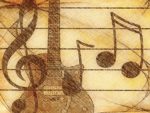
BREAKING FREE FROM LEAD SHEETS WHILE IMPROVISING
The training ground for jazz guitar is the Great American Songbook—the songs that were mostly written in the 30s and 40s. This body of work contains the richest assortment of melodies and harmonies ever produced by man. All of us learn to improvise by playing over the chord tracks of songs from the Great American Songbook. Youngsters who study jazz in music schools are taught to play certain scales over the appropriate chords. I was taught this way by Barry Galbraith, and it works well but can lead to mechanical playing. This approach gets you into the habit of playing from visual cues (the chord signatures). It is a necessary learning phase to get the scale and interval patterns under your fingers. Learning scales and where to use them gives us the muscle memory to navigate the neck and produce improvised melodies. The problem then becomes how to avoid sounding mechanical. You have to learn to improvise from your ears, not your eyes. Here is how I discovered it:
One evening, I was watching a video of a Tony Bennett performance. I was marveling at how much feeling he was able to get into the melodies he was singing. He was singing It Had to Be You, a song that I was very familiar with. After the verse (which is beautiful), there were tears in his eyes. I grabbed my guitar and started to play lines along with him. My hands knew where to go (muscle memory). I was getting good ideas with no lead sheet or thought of chord symbols. “How am I doing this?†I wondered. “I don’t even know what key he is in.†The answer was that my ideas were coming from the melody. I had heard great players say that, when improvising, you should always keep the melody in mind, but when you have been trained to take visual cues from chord symbols on lead sheets, this is hard to do. At that moment, I had no lead sheet (no visual cues) and the melody was right there in front of my nose. I was forced to take my cues from the melody. I was grabbing (executing) right-brain, musical ideas not patterns from chord symbols on a lead sheet. I noticed that the lines I was playing sounded more musical than usual. That was my discovery. I decided to start improvising with CD tracks of the great singers performing the Great American Songbook . . . Tony Bennett, Peggy Lee, Tom Wopat, Ella Fitzgerald, Louis Armstrong, Nancy Lamott, Diana Krall, Rosemary Clooney . . . my CD collection was loaded with this stuff, and I had a little Bose player on the table next to my guitar chair. I closed my music book and started playing from my ears instead of my eyes. It is very satisfying to hear the improvement this has caused.
Of course, the more familiar you are with a song, the better this works. You may fall into patterns from time to time—for example, you may find yourself playing a diminished scale over a 7b9 chord. If you do slip into a pattern such as this, it is secondary to your own internal musical ideas. If you are familiar with the tune, your mind will give you tasteful, sometimes even beautiful, musical ideas. The key is to remember to pay attention to the ideas that are coming from the mysterious, creative part of your mind. Your mind will usually give you ideas that you can grab (execute). The more you try to grab these ideas, the more your muscle memory will improve. The best part of this whole process is that it’s fun. By having the melody right in front of you, your own ideas will flow. The fact that the great singers also had great orchestral arrangements also helps to inspire fun, musical ideas, and guess what? No lead sheet involved! You are improvising from your ears and not from your eyes. The result is much more musical and less mechanical and fun!
—Allen Johnson Jr.
Great article! Thank you.